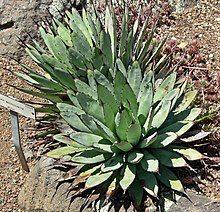Agave macroacantha
| Agave macroacantha | |
|---|---|

| |
| Scientific classification | |
| Kingdom: | Plantae |
| Clade: | Tracheophytes |
| Clade: | Angiosperms |
| Clade: | Monocots |
| Order: | Asparagales |
| Family: | Asparagaceae |
| Subfamily: | Agavoideae |
| Genus: | Agave |
| Species: | A. macroacantha
|
| Binomial name | |
| Agave macroacantha | |
| Synonyms[2][3] | |
|
List of synonyms
| |
Agave macroacantha, the black-spined agave or large-thorned agave, is a species of succulent flowering plant in the family Asparagaceae naturally occurring in Oaxaca and also near the town of Tehuacan in the State of Puebla, Mexico.[4]
Description
[edit]Agave macroacantha produces a medium-sized leaf rosette that can be basal or can grow on a very short stem. Leaves are succulent, greyish green and up to 1.8 feet long at a maximum, ending in sharp black spines that are up to 1.2 inches long at the tips. Flowers are small, grey and red, growing in bunches on sturdy stems of up to 3 m (10 feet) in height.[5]
Cultivation
[edit]The plant prefers a dry, sunny and hot location for summer and from early autumn onwards a cooler, well-lit space. It likes regular watering in summer and only minimum watering in winter, and will fare well in a large pot with sparse, gravelly soil.[6][2][7]
In the UK this plant has gained the Royal Horticultural Society's Award of Garden Merit.[8]
References
[edit]- ^ García-Mendoza, A.J.; Torres-García, I.; Casas, A.; Sandoval-Gutiérrez, D. (2019). "Agave macroacantha". IUCN Red List of Threatened Species. 2019: e.T115645621A116354068. doi:10.2305/IUCN.UK.2019-3.RLTS.T115645621A116354068.en. Retrieved 19 November 2021.
- ^ a b Cactus Art Nursery, Agave macroacantha viridis
- ^ The Plant List, Agave macroacantha
- ^ Zuccarini, Joseph Gerhard. Nova Acta Physico-medica Academiae Caesareae Leopoldino-Carolinae Naturae Curiosorum Exhibentia Ephemerides sive Observationes Historias et Experimenta 16(2): 676. 1833.
- ^ Gentry, Howard Scott. Agaves of Continental North America. University of Arizona Press, Tucson, 1992.
- ^ San Marcos Growers, Agave macroacantha
- ^ Jurassic Garden.com: Agave macroacantha Archived 2015-09-28 at the Wayback Machine, image.
- ^ "RHS Plantfinder - Agave macroacantha". Royal Horticultural Society. 2017. Retrieved 5 January 2018.
- The Complete Encyclopedia of Succulents by Zdenek Jezek and Libor Kunte

